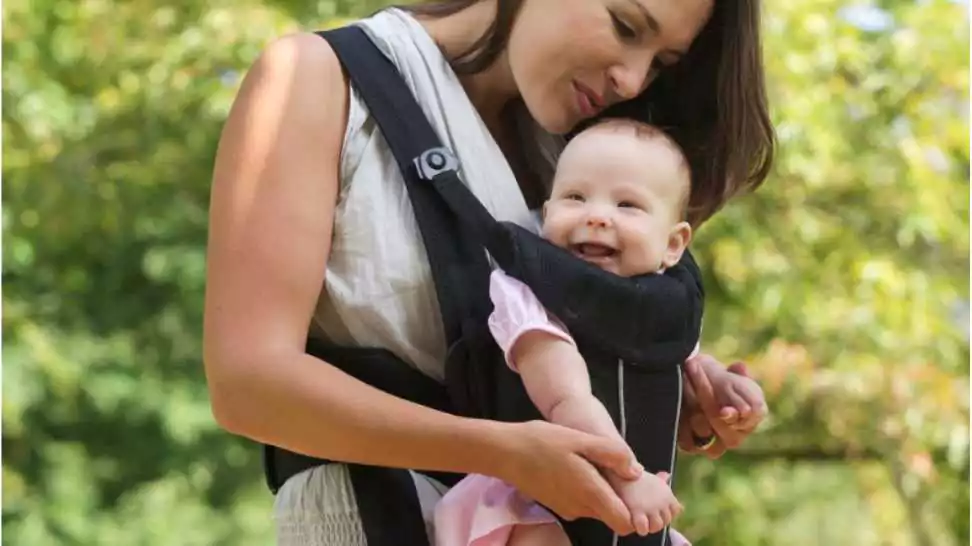How To Carry Baby In Baby Carrier?

In our fast-paced modern world, baby carriers have become indispensable for new parents. They offer the dual benefits of bonding with your baby and the freedom of hands-free mobility. This guide is designed to help new parents navigate the intricacies of babywearing, from selecting the right carrier to ensuring your baby’s safety and comfort.
We’ll provide detailed instructions on the practical aspects of babywearing, focusing on “how to carry baby in baby carrier” and “when to carry baby in carrier.” These insights are crucial for your baby’s development and your ease of parenting. Our comprehensive approach covers everything you need to know for a safe, enjoyable baby-carrying experience, making this journey into parenthood both fulfilling and secure.
1 Understanding Baby Carriers

Navigating the world of baby carriers can be as complex as it is exciting. With a variety of types available, each catering to different needs and preferences, it’s essential to understand the options to make the best choice for you and your baby.
Different Types of Baby Carriers
- Wraps: Wraps are long pieces of fabric that you can tie around your body in various ways. They offer a snug, custom fit and are excellent for newborns due to the close body contact they facilitate.
- Slings: Slings are typically made from a wide piece of fabric looped over one shoulder and across the torso. They are ideal for quick and easy baby wearing, suitable for infants who enjoy being held close.
- Structured Carriers: These are more robust, with padded shoulder straps and waistbands, offering excellent support for both the baby and the parent. They are ideal for older babies and toddlers due to their structured design and weight distribution.
Pros and Cons of Each Type
Wraps:
Pros: Highly adjustable, promoting skin-to-skin contact, and evenly distributes baby’s weight.
Cons: Steeper learning curve in tying techniques, can be time-consuming to set up.
Slings:
Pros: Easy to use, compact, and great for breastfeeding.
Cons: May not distribute weight as evenly as other carriers, less suitable for longer wear periods.
Structured Carriers:
Pros: Supportive, user-friendly, and ideal for long durations of wear.
Cons: Can be bulkier and more expensive, less suitable for newborns without proper inserts.
How to Choose the Right Carrier for Your Baby and Lifestyle?
Choosing the right carrier involves a balance of comfort, convenience, and lifestyle compatibility. Consider the following factors:
- Baby’s Age and Development: Newborns need more head and neck support, making wraps or slings a better choice initially. Older babies and toddlers may benefit from the structured support of a carrier.
- Parent’s Comfort: Evaluate what feels comfortable for your body type. Structured carriers often provide more back support, which can be crucial for longer wear periods.
- Lifestyle Needs: If you’re frequently on the go or enjoy outdoor activities, a sturdy structured carrier might be ideal. For those who prioritise ease of use for quick errands, a sling could be more suitable.
- Climate: Consider the weather in your area. Lighter fabrics are better for hot climates, while padded carriers offer warmth in colder environments.
- Adjustability and Longevity: Some carriers grow with your child and can be adjusted for different carry positions, offering more value over time.
2 Preparing to Use a Baby Carrier

Before you embark on the journey of baby wearing, it’s crucial to prepare adequately to ensure both your comfort and your baby’s safety. Here’s how you can get started:
Safety Considerations Before Using a Carrier
- Check for Damage: Before each use, inspect the carrier for any signs of wear or damage, such as torn fabric or loose stitching, to prevent accidents.
- Understand Weight and Age Guidelines: Each carrier type has specific weight and age recommendations. Ensure your baby fits within these guidelines for their safety.
- Practise Safe Positioning: Familiarise yourself with the ‘M’ position, where your baby’s knees are higher than their bottom, forming a natural, ergonomic seating position. This is crucial for healthy hip development.
- Ensure Airway Clearance: Always ensure your baby’s face is visible and their airway is clear. The chin should not be pressed against the chest, and the fabric should not cover the face.
- Learn Secure Fastening: Understand how to securely fasten and adjust the carrier. If it’s a wrap or sling, practise the knots and wraps without the baby first.
Adjusting the Carrier for Comfort and Safety
- Straps and Buckles: Adjust the straps and buckles to fit your body snugly but comfortably. The carrier should be tight enough to hug your baby close to you but not so tight that it’s uncomfortable.
- Waistband Positioning: For structured carriers, the waistband should sit on your natural waist or slightly above the hips to distribute weight evenly and reduce lower back strain.
- Back and Shoulder Comfort: Adjust shoulder straps so that they don’t dig into your shoulders or back. Some carriers have a cross-back option for better weight distribution.
- Baby’s Position: Ensure your baby is seated deeply in the carrier, with their weight resting on their bottom, not their feet or legs.
Introducing Your Baby to the Carrier
- Choose a Calm Time: Start when your baby is calm and content, not during times of distress or sleepiness.
- Gradual Introduction: Allow your baby to get familiar with the carrier by placing them in it for short periods initially, gradually increasing the time.
- Maintain Physical Contact: Keep a hand on your baby while moving, to reassure them and provide additional support.
- Monitor Baby’s Response: Pay attention to your baby’s cues. If they seem uncomfortable or fussy, re-adjust the carrier or try a different position.
- Stay Attentive: Always keep an eye on your baby, especially in the first few uses, to ensure they are safe and comfortable.

3 How to Carry Baby in Carrier?
Successfully carrying your baby in a carrier not only provides comfort and convenience but also fosters a closer bond between parent and child. Here’s a detailed guide on how to do it right.
Step-by-Step Guide for Placing Baby in the Carrier

- Prepare the Carrier: If using a wrap or sling, pre-tie it according to instructions. For structured carriers, adjust the straps loosely to make placing the baby easier.
- Position the Baby: Gently lift your baby and place it against your chest. In a newborn, ensure their legs are in a frog-like position; older babies can have their legs around your waist.
- Secure the Baby: Slide the baby into the carrier. In a wrap or sling, ensure the fabric covers the baby’s back, extending from one knee to the other. In a structured carrier, buckle and tighten the straps securely.
- Double-Check Security: Ensure that all buckles are fastened correctly, and the fabric is snug. The baby should be close enough to kiss their forehead without straining.
Ensuring Proper Posture and Alignment for the Baby
‘M’ Position: The baby’s knees should be higher than their bottom, forming an ‘M’ shape, which is essential for healthy hip development.
Spine Alignment: The baby’s back should be in a natural, slightly curved ‘C’ shape. Avoid over-straightening.
Head Support: For newborns and sleeping babies, provide extra support for the head and neck.
Comfort Tips for the Parent While Carrying the Baby
- Distribute Weight Evenly: Adjust the straps so that the baby’s weight is evenly distributed across your shoulders and hips.
- Use Waist and Hip Support: For structured carriers, utilise the waistband for additional support, reducing lower back strain.
- Change Positions Regularly: To prevent muscle fatigue, alternate between different carrying positions or switch sides if using a sling.
- Wear Comfortable Clothing: Choose clothes that are comfortable and supportive, avoiding anything that might dig into your skin under the carrier’s straps.
Common Mistakes to Avoid
- Ignoring the Baby’s Cues: Always stay attuned to your baby’s needs and comfort. Discomfort or distress signals should be addressed immediately.
- Improper Positioning: Avoid carrying the baby too low or too loosely, as it can be unsafe and uncomfortable for both the baby and the parent.
- Neglecting Personal Comfort: Don’t ignore your comfort. If you’re uncomfortable, adjust the carrier or take a break.
- Overheating: Be cautious of the baby’s and your body temperature, especially in warm weather or when indoors.
4 When to Carry Baby in a Carrier?
Baby wearing can be a wonderful way to bond with your baby while keeping your hands free, but it’s essential to understand when it’s appropriate and beneficial to carry your baby in a carrier.
Understanding the Right Age and Stage for Baby wearing
- From Newborn to Toddler: Baby carriers can be used from the newborn stage until toddlerhood, though the type of carrier and carrying position will vary as your baby grows.
- Newborns (0-3 months): They require a carrier that supports their head and neck. Wraps and slings are usually ideal for this stage.
- Infants (3-6 months): Once they have stronger neck and head control, you can transition to different types of carriers, depending on your preference.
- Older Babies and Toddlers: Structured carriers are often more comfortable as your child grows and becomes heavier, offering better support and weight distribution.
Signs Your Baby is Ready for a Carrier
- Head Control: Your baby can hold their head up steadily, which is crucial for safe baby wearing.
- Size and Weight: They meet the minimum size and weight requirements specified by the carrier manufacturer.
- Interest in Surroundings: Your baby shows curiosity about their surroundings, indicating that they might enjoy the elevated view from a carrier.
Recommended Duration and Frequency of Baby wearing
- Start with Short Sessions: Initially, limit baby wearing to short durations, gradually increasing as both you and your baby become more comfortable.
- Follow Your Baby’s Cues: Some babies love to be worn for extended periods, while others may prefer shorter sessions. Be responsive to their needs.
- Balance is Key: While baby wearing can be beneficial, it’s also important to give your baby time to explore and move independently.
Adapting Baby wearing as Your Child Grows
- Adjust the Carrier: As your baby grows, adjust the carrier to ensure it fits properly and provides adequate support.
- Change Positions: Experiment with different carrying positions to find what’s most comfortable for you and your child at each stage.
- Stay Informed on Weight Limits: Be aware of the weight limit of your carrier and transition to a more suitable option if needed as your child grows.
- Incorporate Baby wearing into Daily Routine: As your child becomes more active, baby wearing can be a great way to keep them engaged and close while you go about your daily tasks.

5 Troubleshooting Common Issues
While baby wearing can be a delightful experience, it’s not uncommon to encounter a few challenges along the way. Here’s how to address some of the most common issues you might face.
Dealing with Discomfort or Pain While Using the Carrier
- Check Your Posture: Ensure you’re standing straight with your shoulders back. Slouching can cause back and shoulder pain.
- Re-adjust Straps: If the carrier feels uncomfortable, try adjusting the straps. Even a small adjustment can make a big difference in weight distribution.
- Use Padded Straps: If your carrier’s straps are digging into your shoulders, consider a carrier with padded straps or add strap pads for extra comfort.
- Switch Carrying Positions: Alternate between different carrying positions to prevent muscle fatigue.
- Take Breaks: Don’t hesitate to take the carrier off and give yourself a break if you start feeling discomfort.
Adjusting the Carrier as the Baby Grows
- Regular Fit Checks: Periodically check the fit of the carrier as your baby grows. A carrier that was perfect a month ago might need adjustments now.
- Alter Carrying Positions: As your baby gets older, explore different carrying positions that are appropriate for their age and development stage.
- Adjust for Baby’s Height and Weight: Make sure the carrier supports your baby’s thighs and allows their legs to be in an ‘M’ position for healthy hip development.
- Consult the Manual: Refer to your carrier’s manual for specific instructions on adjusting it for different ages and sizes.
Tips for Baby wearing in Different Weather Conditions
Hot Weather:
- Use carriers made from breathable, lightweight fabrics.
- Dress your baby in light clothing.
- Use a sunhat for your baby and apply sunscreen as needed.
- Stay hydrated and take breaks to cool off.
Cold Weather:
- Choose carriers with warmer materials or use a carrier cover.
- Dress your baby in layers.
- Protect your baby’s head, hands, and feet from the cold.
- Avoid overheating by not over-bundling.
Rainy or Windy Conditions:
- Use a waterproof carrier cover.
- Dress your baby in appropriate rain or wind gear.
- Protect your baby’s face from harsh winds.
6 Wrapping Up
Baby wearing is more than a convenience; it’s a unique way to bond and support your baby’s growth while exploring the world together. Remember to prioritise safety and comfort, as outlined in our guide, for a rewarding baby wearing experience.
We’d love to hear from you! Share your baby-wearing stories, tips, and favourite carriers to help other parents on their journey. Your experiences can offer invaluable guidance to those new to baby wearing.
Thank you for exploring the world of baby wearing with us. Here’s to many cosy, secure, and joyous moments with your little one!
Community Q&A
About This Article
This article has been viewed 90 times.




Awesome! Its genuinely remarkable post, I have got much clear idea regarding from this post